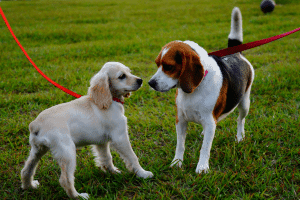Do you have an upcoming move and you’re wondering how to make the transition easier on your furry, four-legged family member? Well, look no further. With a little pre-planning and consideration, you’ll have your canine companion comfortable in no time. Read on to learn some helpful tips for moving to a new house with a dog without causing unnecessary stress and discomfort for either of you.
How to Prepare Your Dog for the Move
 Let your dog explore the area. Dogs are territorial by nature and are generally attached to their homes, so they can become uncomfortable when introduced to an unfamiliar area. In the weeks leading up to your move, take your dog for walks around the new neighborhood. Be sure to take things slowly and give your dog plenty of time to investigate the new sights and smells.
Let your dog explore the area. Dogs are territorial by nature and are generally attached to their homes, so they can become uncomfortable when introduced to an unfamiliar area. In the weeks leading up to your move, take your dog for walks around the new neighborhood. Be sure to take things slowly and give your dog plenty of time to investigate the new sights and smells.- Look for nearby dog parks. Taking your pup to a local dog park is a great way to introduce him to other animals that live in the area. A few interactions before the move can help your dog become familiar with other local pets, removing the dangers of introducing him when he’s already tense.
- Do a safety check around the new home. Check fencing to make sure there are no holes your dog can escape through, and keep an eye out for any loose areas that he may be able to push his way past. Walk through outside spaces and remove any potential hazards, such as leftover chemicals from previous tenants or chewable items that could cause a blockage if swallowed.
- Introduce your dog to the local vet. If you are moving your dog to a new home that’s far away, consider finding a new veterinarian. Ask your vet about any health issues common in the area, such as ticks, fleas, or heartworm. You might want to consider purchasing the necessary preventive measures as soon as possible. You may also want to find a new groomer and kennel facility.
- Make sure all your dog’s vaccines are up to date. Memphis law requires that all dogs be up to date on their rabies vaccine and licensed yearly, so take care of these things before the move to avoid unnecessary stress and prevent expensive trips to the vet after exposure to diseases from unfamiliar dogs.
- If your dog doesn’t wear a collar, get him used to one now. Dogs are most likely to run off when they are stressed and in an unfamiliar place, so it’s important that your pet has identification to make it easier for anyone who finds him to contact you. The collar should fit snugly enough to prevent pulling it over his head without restricting breathing and should be fitted with an easy-to-read tag that includes your dog’s name and a current phone number.
How to Settle Your Dog Into a New House
 Maintain your normal routine. Moving can often disrupt your daily schedule, but moving with a puppy or older canine requires that you keep as close to your regular routine as possible. Your dog does not understand the reasons for change, and it can be terrifying to experience too many changes at once. Keeping a schedule that he is used to will allow him to take comfort in familiar routine and give him less reason to be anxious. This can be beneficial especially when moving an old dog to a new home.
Maintain your normal routine. Moving can often disrupt your daily schedule, but moving with a puppy or older canine requires that you keep as close to your regular routine as possible. Your dog does not understand the reasons for change, and it can be terrifying to experience too many changes at once. Keeping a schedule that he is used to will allow him to take comfort in familiar routine and give him less reason to be anxious. This can be beneficial especially when moving an old dog to a new home.- Unpack favorite items first. Your dog likely has a favorite toy, blanket, or bed. When you begin to unpack, make those items a priority, and place them in a quieter area of your new home. This will allow your dog to take comfort in familiar scents without being overwhelmed by all the unpacking activity. If your dog is kennel trained, keep the kennel in a quiet place with the door open so he has a safe place to hide when things feel too stressful.
- Spend extra time at home in the beginning. If it’s at all possible, take a few days off to stay home with your dog. When dogs experience traumatic change like a move, it can be easy for them to worry that more change is coming. This often creates separation anxiety due to his fear that he is also going to lose you. Having you there by his side will reassure him that everything is going to be okay.
- Keep calm. This is the most important thing to remember. It can be extremely stressful and frustrating to move with a dog. His behavior may change in response to heightened anxiety levels, and he may act out with new, undesirable habits such as chewing or barking. It is important that you don’t allow yourself to get frustrated, because your dog can sense your emotions. If he feels that you are upset, his stress levels will go up in response. Speak soothingly to him, and take extra time to cuddle and play with him. He depends on you more than anything else, so reassure him that his relationship with you isn’t going to change.
Moving with a dog can add stress to an already stressful situation, but there are several things you can do to ensure a smooth transition. Taking the time to learn how to settle a dog into a new house will help you both avoid unnecessary anxiety and approach the upcoming changes with confidence. The extra time spent to help your pet adjust will also bring you closer together, creating greater trust in you, and will give your dog less reason to act out. If you take the time to approach your move with your dog’s feelings in mind, your furry friend will feel at home in your new place in no time.
